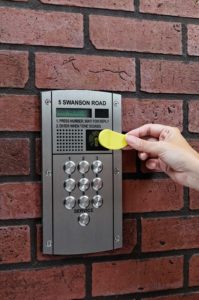
With advances in access control technology, key fobs and readers are replacing traditional locks and keys. Lloyd Palmer, Area Manager at PAC GDX, examines what specifiers should consider when selecting access control for social and affordable housing.
The latest access technology utilises key fobs and/or smartcards and for residents, especially the elderly or those with disabilities, these types of devices are far more convenient than having to remember personal identification number (PIN) codes. Just as importantly, building managers can monitor patterns of behaviour to ensure residents are safe, while also combating antisocial activities.
Modern access control technology encompasses everything from locally controlled single door solutions to multi-door Internet protocol (IP) enabled systems that can be remotely managed and fully integrated with other building services such as CCTV, fire detection and intruder alarms. In fact, the latest state-of-the-art systems offer an entirely multifaceted access control experience and are easy to configure and operate. Also, they have virtually unlimited system expansion capabilities, which equates to an abundance of cost saving and centralisation benefits.
Gloucester City Homes is a great example of how this works in practice. Using PAC controllers and modems, it has created a highly innovative remote monitoring platform that can be accessed via a PC, tablet or Smartphone. The system has been fully integrated with the PAC Residential Cloud. This allows designated personnel to access information remotely and enables remote diagnostics, technical issues, servicing and key fob management to be carried out by a team of over 25 people, who can view status, set and unset a system, and access an event log from anywhere.
Support structure
When it comes to design and functionality, it is advisable to choose a solution that has been approved by Secured by Design, a group of national police projects focusing on the design and security for new and refurbished homes, commercial premises and car parks.
With continuing uncertainly about the implications of Brexit, a product that is made in Britain and has local technical support is well worth considering, and could make any warranty-related issues less onerous. With regard to warranties, check what type is on offer — for instance, a return to base warranty means that should a fault develop within the warranty period, the product will have to be sent to a service centre for repair before being returned. If it cannot be repaired, a new product will be delivered. However, under the terms of an advance replacement warranty, the manufacturer immediately delivers a replacement product in the event of a problem.
Using approved installers that have undertaken correct manufacturer training and received certification is vital. Tender documents should specify this as a requirement and public sector procurement frameworks, such as Fusion 21 and LHC, can bring cost efficiencies by helping customers to buy smarter and with confidence.
The sky’s the limit
Cloud-based systems are not inherently insecure but due diligence should always be carried out. It pays to ask questions about, for example, what measures a manufacturer takes to ensure that data is as safe as possible. Without proper data security measures in place, if it is lost or stolen, organisations may face heavy fines — noted in the General Data Protection Regulation (GDPR).
In order to mitigate against these risks and as part of a comprehensive, multi-layered approach to data protection and information security, controlling where information is stored becomes a critical consideration. Therefore, check that the data centre that stores any information from an access control system is certified to the ISO 27001 standard for information security management.
Lost and found
Keys can be lost, stolen and copied, leaving assets vulnerable and requiring an expensive change of locks. Blackpool Coastal Housing utilises cloud-based remote monitoring, so if someone loses a key fob the organisation can access their information, carry out an authorisation check, let them into their abode and, if necessary, deactivate the missing device.
It is also possible to generate reports that indicate if a key fob has not been used for a specific period of time and Blackpool Coastal Housing can take measures to deactivate it, send someone over to check on the person concerned and, if necessary, notify next of kin or the relevant authorities. In extreme circumstances, it can also remotely open doors to allow access to the emergency services, while in less serious cases it is possible to reset a key fob remotely without having to send an operative to carry out the work manually – saving both time and money and making best use of resources.
Thinking ahead
Today’s high performance access control systems provide a sophisticated level of operation, with positive implications for tenant satisfaction and health and safety. Also, in the event of a theft or anti-social behaviour, it is possible to pinpoint exactly who was where and when, and initiate appropriate action, using live event and reporting tools. The cloud and the growth of system integration are propelling the access control sector forward in ways not seen before and providing greater functionality for local authorities as a result.
Header image: One of Blackpool Coastal Housing’s schemes use PAC and GDX systems









